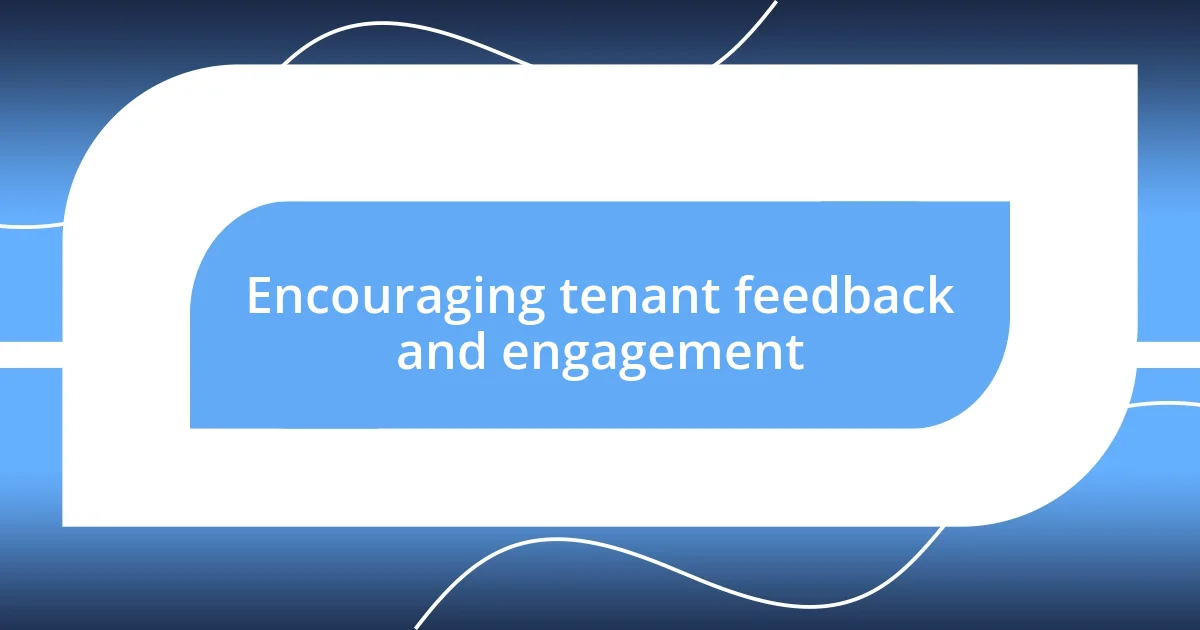Key takeaways:
- Effective communication fosters trust, encourages tenant engagement, and enables proactive conflict resolution, creating a supportive living environment.
- Setting clear expectations through accessible guidelines and consistent communication prevents misunderstandings and empowers tenants to feel comfortable and valued.
- Encouraging tenant feedback and responding to their needs not only strengthens relationships but also cultivates a sense of community and belonging among residents.

Understanding tenant relationships
Understanding tenant relationships is more than just maintaining a business transaction; it’s about building a community. I remember my first year as a landlord, struggling to connect with my tenants. One day, after resolving a maintenance issue, a tenant shared that they felt isolated in their new neighborhood. This moment made me realize how essential it is to foster an environment where tenants feel valued and heard.
When I think about what makes tenant relationships thrive, communication stands out as a cornerstone. Have you ever had a situation where you wished someone was just a text away for a quick question? I’ve found that being approachable and responsive can transform the dynamic. It creates a sense of trust. I recall the time when I took the extra step to check in on a tenant during a heatwave—just a simple text. That brief interaction turned into a conversation about community events, deepening our connection.
Empathy also plays a significant role in nurturing these relationships. I’ve seen how understanding tenants’ perspectives can lead to more meaningful interactions. For instance, I learned that a tenant was struggling with balancing work and family life. By offering flexible solutions, I didn’t just solve an immediate problem—I built goodwill and loyalty. Isn’t it rewarding when you realize that your efforts can directly impact someone else’s comfort and happiness? Establishing positive relationships not only benefits tenants but enriches our experiences as landlords.

Importance of communication with tenants
Strong communication with tenants isn’t just beneficial—it’s essential. I’ve learned that initiating open dialogues often leads to unexpected insights about their needs and concerns. For example, I once received a call from a tenant expressing frustration about a noisy neighbor. Instead of just addressing the issue, I found it was an opportunity to discuss ways to foster better relationships among residents. This conversation not only resolved the immediate concern but also allowed the tenant to feel empowered, knowing their voice mattered.
Here are some critical reasons why communication is vital:
- Trust Building: When tenants know they can reach out, they’re more likely to trust me with their issues.
- Conflict Resolution: Open lines of communication help diffuse potential conflicts before they escalate.
- Engagement: Regular check-ins, whether via email or casual chats, make tenants feel included in their living environment.
- Feedback Loop: Tenants’ feedback can offer valuable insights into property management adjustments, leading to improved satisfaction.
- Community Atmosphere: A friendly rapport encourages tenants to connect with each other, which enhances the overall living experience.

Setting clear expectations with tenants
Setting clear expectations with tenants lays the foundation for a harmonious relationship. I recall a situation where I provided a comprehensive welcome packet detailing all the house rules and maintenance protocols. It was fascinating to see how this simple gesture alleviated uncertainties and fostered a positive atmosphere right from the start. When tenants know what’s expected of them—and what they can expect from me—trust naturally develops.
An example that stands out in my mind involved a tenant who was new to renting. They had numerous questions about everything from rent due dates to how to handle repairs. By creating an easily accessible guideline, I reduced their anxiety and built a strong rapport. I firmly believe this clarity not only prevents misunderstandings but also shows tenants that their comfort matters. Doesn’t it feel good to know exactly where you stand?
Additionally, regular conversations to revisit these expectations can reinforce understanding. I make it a point to check in periodically to discuss any changes or concerns. One tenant even suggested a few adjustments that benefited everyone living in the building. These moments highlight how collaborative communication truly strengthens bonds, creating a community where everyone feels at home.
| Expectation | How to Communicate |
|---|---|
| Rent Payment | Clear deadlines and methods of payment |
| Maintenance Issues | Define how to report issues and response times |
| Community Events | Share plans for gatherings to encourage participation |

Building trust through transparency
Building trust through transparency is a practice I’ve found to be incredibly rewarding. I recall a time when I had to address some upcoming maintenance work, which could disrupt a few tenants’ routines. Instead of simply sending out a notice, I took the time to explain the reasoning behind it, as well as how long the work would take. The tenants appreciated being included in the conversation and voiced their concerns, allowing us to find solutions together. This openness not only eased their worries but also strengthened their trust in me as their landlord.
I also learned that being transparent about my own expectations and processes can foster a deeper relationship. For instance, when discussing rent renewal, I lay out the factors influencing rent adjustments openly. By sharing how I determine rates and the importance of market conditions, tenants see that my decisions are grounded in fairness, not just profit. This not only mitigates anxiety but also invites their input and concerns. Have you ever felt relieved when someone has taken the time to explain their decisions? That shared understanding creates a bond I cherish.
Transparency isn’t just about sharing information; it’s about building a culture of honesty. During one community meeting, I encouraged tenants to voice any grievances and assured them that their feedback would be used constructively. Some were hesitant at first, but as the discussion unfolded, the atmosphere became more relaxed, and they shared insightful perspectives. Witnessing that transformation reinforced my belief in the power of transparency; it allows tenants to feel seen and valued. Ensuring they know their opinions matter creates a trust-filled environment where everyone feels at home.

Responding effectively to tenant needs
Responding effectively to tenant needs is a critical aspect of nurturing positive relationships. I remember receiving a late-night call from a tenant who had a plumbing emergency. Instead of just relaying my availability for repairs, I reassured them that their comfort and safety were my top priorities. Recognizing the urgency of the situation, I sprang into action. There’s something deeply rewarding about knowing you’re there to help someone in distress. How often do we really consider the emotional side of these interactions?
Listening goes a long way in understanding tenant needs. One afternoon, I spent some time in the common area and overheard a couple of tenants chatting about their concerns over heating issues that hadn’t been fully addressed. By simply engaging them in conversation, I gathered valuable insights and immediately organized a maintenance check. Have you ever felt frustrated when your concerns fell on deaf ears? I realized that being proactive not only took care of the problem but also made the tenants feel heard and validated.
Sometimes, it’s about creating a feedback loop that encourages open dialogue. I launched a simple online survey to gauge tenant satisfaction and to learn about areas needing improvement. Surprisingly, many tenants jumped at the chance to share their thoughts—some even left personal notes expressing gratitude for the opportunity. These moments remind me that responding effectively is not just about fixes; it’s about fostering a community where tenants feel empowered to share their voices. How fulfilling it is to cultivate that environment!

Creating a welcoming environment
Creating a welcoming environment begins with small yet impactful gestures. I recall a time when I decided to brighten my tenants’ experience by personally welcoming new residents with a small basket of local treats and a handwritten note. It was heartwarming to see their smiles and to hear them mention how appreciated they felt. Have you ever walked into a new place and been greeted with warmth? That kind of genuine hospitality sets the tone for an open and friendly atmosphere.
I genuinely believe that the physical space should reflect a sense of belonging too. About a year ago, I introduced a community garden in our shared outdoor area, inviting residents to contribute. This simple initiative not only beautified the space but also brought tenants together, creating friendships and promoting interaction. When I walk through the garden and see neighbors chatting over their plants, it fills me with such joy. Isn’t it amazing how a little greenery can turn a place into a thriving community?
Establishing clear communication is also vital to creating a welcoming environment. After noticing some tenants felt hesitant to approach me, I set up monthly coffee hours where anyone could drop in to talk casually. I remember one resident sharing how grateful they were for the opportunity to connect outside of formal meetings. These moments foster trust and rapport, highlighting the impact of being accessible. Have you ever felt a shift in your relationship with someone simply because you took the time to share a cup of coffee? Those relaxed conversations can work wonders in making people feel at home.

Encouraging tenant feedback and engagement
Encouraging tenant feedback is vital to building a thriving community. I’ve found that actively inviting tenants to share their opinions can lead to surprising discoveries. One time, after a community event, I opened the floor for suggestions. I was genuinely shocked to hear feedback about the types of activities they wanted. It highlighted how a little openness can spark enthusiasm and foster deeper connections. Have you ever noticed how people tend to hold back their thoughts until they feel welcomed to express them?
Engagement goes beyond just asking for feedback—it’s about creating avenues for continuous conversation. I remember implementing a “Suggestion Box” in the lobby, and to my delight, it quickly filled up. It became a fun ritual for me to check it weekly, and I frequently found myself smiling at honest and creative ideas from tenants. It made me feel more in tune with their needs and added an element of surprise to my week. How can we ever grow if we don’t open the door to diverse perspectives?
Regularly sharing updates based on tenant feedback can solidify that sense of community. After a round of suggestions about parking, I communicated changes that were implemented as a direct result. When tenants saw their voices made tangible change, it empowered them to engage even more. I felt such a rewarding sense of accomplishment—seeing them visibly proud of their contributions left an indelible mark on the community atmosphere. How fulfilling it is when we witness the fruits of collaboration in action!














